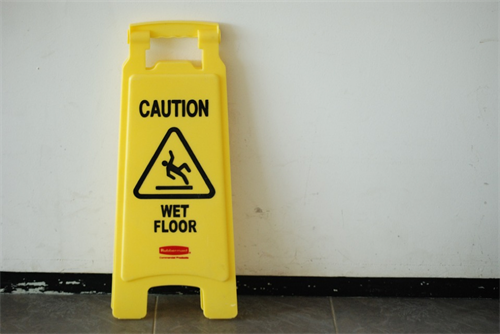Reduce Slips, Falls, and Injuries in Your On-Premises Laundry Room With These 17 Tips

Each year, 37.3 million falls are severe enough to require medical attention, according to the World Health Organization. On top of that, back injuries — often from lifting and repeated motions over time — account for nearly 20% of all injuries and illnesses in the workplace according to OSHA. Those working in on-premises laundry rooms can be at an increased risk for falling and back, neck, and shoulder injuries, especially when dealing with wet floors, transporting large loads of linens and equipment, and navigating around laundry carts and baskets. Of course, no housekeeping or maintenance manager wants to see their employees hurt or deal with a costly and time-consuming lawsuit. The WHO emphasizes prevention and education as the best strategies to help reduce falls. With that in mind, we’ve put together a few tips and tricks to reduce slip and fall hazards in your on-premises laundry room.
1. Use clear signage. Wet floor and out of order signs should be easily accessible and placed as soon as possible after a spill or leak occurs. Signs are a great first step in making staff and customers aware of potential slipping hazards.
2. Clean up spills quickly. When a spill occurs, cleaning it up should be a top priority to make sure no one accidentally falls. This may be a no brainer, but when employees are busy or rushed, it’s easy to forget, get distracted, or assume someone else will take care of it.
3. Assign responsibilities. While safety should be everyone’s responsibility, that’s not always the case. Make sure it’s clear (and documented) who is responsible for handling leaks, spills, and other tripping hazards, and/or who to call if an emergency occurs. All safety processes should be documented and employees should be trained how to follow them appropriately.
4. Never work alone. Injuries often happen when someone is left by themselves. Working as a team assures there’s someone to offer assistance if an incident occurs or someone needs help. Since no one is ever left to their own devices, it also helps keep the team accountable when it comes to following safety and cleanliness procedures.
5. Protect yourself when moving equipment. Laundry equipment is heavy. Make sure to utilize proper tools, such as dollies, lifting straps, and forklifts, to protect your back from injury. If you are lifting heavy boxes, equipment, or pushing carts, be sure to lift with your legs, not your back.
6. Keep soaps and chemicals stored away when not in use. This will help prevent employees from accidentally knocking soaps and chemicals off the counter and around the laundry equipment, which can create a slippery floor and wastes your products. Keeping soaps and other materials stored at an easily accessible height can also reduce the need for climbing on step stools or ladders, which can increase the risk of falling.
7. Use cable protectors and cord guards to keep cords from becoming tripping hazards. As staff are carrying large loads of linens and pushing carts, the last thing you want is a cord in the way to trip them up. Make sure all cords are secured and safely out of walkways.
8. Improve lighting. It is much easier to see potential tripping hazards or other dangers in a well-lit space. Add additional lights, increase natural lighting with windows, and replace burned out bulbs as needed.
9. Reverse tumble dryers. This will help prevent large items, such as sheets and bedding, from getting tangled. It is easy to wrench your back when you get resistance trying to pull tangled up linens from the machines.
10. Require proper footwear. Anti-slip shoes with good support can help keep your employees safe when moving around the laundry facility. It also just gives a strong, comfortable foundation as employees are lifting loads of laundry, pushing cars, and other strenuous activities throughout the day.
11. Use non-skid rugs or mats. These special non-slip mats are helpful around doors, utility sinks, and drying racks where water, wet feet, and other debris that can make flooring slippery.
12. Have designated areas for laundry carts, bins, and boxes. As employees are loaded down with linens and oftentimes distracted, anything in their path can be a tripping hazard. You’ll want to be sure there’s a designated area for carts, bins, and other boxes to keep them out of the way when not in use.
13. Check floor conditions regularly. Broken or cracked tile, worn down carpeting, or rugs that are flipped up are all potential tripping hazards. Even rags, towels, and other linens that accidentally fell on the floor can prove to be a hazard. It should be part of your regular routine to check floors for potentially dangerous areas and keep an eye out for spills, leaks, and other hazards.
14. Plan for the weather. Slips and falls often happen when snow, rain, and mud are tracked in from outside and make the flooring extra slippery. On-premises laundry room managers and employees should keep track of severe weather and plan ahead. That may mean pulling out extra rugs, fans, and wet floor signs ahead of time or having staff change into dry shoes once inside.
15. Document actions in a safety log. Every time you do something to improve safety and reduce hazards in your on-premises laundry room — whether it’s cleaning the floors or putting up wet floor signs — take the time to document it in a safety log. Filling out this report will get employees used to keeping safety top of mind and can come in handy if an incident occurs and insurance companies get involved. If someone does get injured, be sure that’s documented as well.
16. Don’t overfill your washers. Always follow the machine instructions and capacity to avoid overfilling your washing machines, which can lead to leaks and slippery, wet floors. Employees can also easily injure their back when trying to unload or load too many linens at once.
17. Use UniMac and UniLinc technology. UniLinc is a complete OPL control system that allows you to gather machine performance and maintenance data in your on-premises laundry room. This includes automatic water leak detection and slow drain detection, which can help you catch potential issues on your industrial laundry equipment before they become bigger problems — such as a leak.
